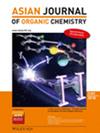具有四DPP臂的星形β -取代卟啉有机太阳能电池
IF 2.8
4区 化学
Q1 CHEMISTRY, ORGANIC
引用次数: 0
摘要
卟啉是一类非常重要的发色团,在许多领域都有广泛的应用。近年来,中间体官能化卟啉在光电探测器、染料敏化太阳能电池(DSSCs)和有机太阳能电池(OSCs)等领域取得了很大进展。为了探索新的化学结构与功能化卟啉之间的关系,本文设计并合成了两种星形β -取代卟啉- 4β - EDPP - Por和4β - DPP - Por,它们的四个DPP臂分别通过乙烯和单键连接在卟啉核心的2、8、12和18 - β -位上。这两种卟啉的吸收光谱、能级排列和分子构型与先前在卟啉介位官能化的A - D‐A型分子不同。基于4β - EDPP - Por:Y6和4β - DPP - Por:Y6活性层的全小分子有机太阳能电池(ASM - OSCs)的功率转换效率分别为5.64%和6.96%。该研究丰富了卟啉光电子材料的多样性,为开发星形小分子有机光电子供体材料提供了一条实用的途径。本文章由计算机程序翻译,如有差异,请以英文原文为准。
Star‐Shaped Beta‐Substituted Porphyrins with Four DPP Arms for Organic Solar Cells
Porphyrins are a very important class of chromophores that have been widely applied in many fields. In recent years, the porphyrins functionalized at the meso‐positions have made much progress in photovoltaic fields, including photodetectors, dye‐sensitized solar cells (DSSCs) and organic solar cells (OSCs). In order to explore the relationship between new chemical structures and the properties of functionalized porphyrins, herein, two star‐shaped β‐substituted porphyrins 4β‐EDPP‐Por and 4β‐DPP‐Por with four DPP arms linked at 2, 8, 12, and 18‐β‐positions of a porphyrin core by ethynylenes and single‐bonds, respectively, are designed and synthesized for OSCs. The two porphyrins exhibit absorption spectra, energy level arrangements, and molecular configurations different from those of the A−D‐A‐type molecules previously functionalized at porphyrin meso‐positions. The power conversion efficiencies (PCEs) of the all‐small‐molecule organic solar cells (ASM‐OSCs) based on the active layers of 4β‐EDPP‐Por:Y6 and 4β‐DPP‐Por:Y6 are 5.64 % and 6.96 %, respectively. This study enriches the diversity of porphyrin optoelectronic materials and provides a practical approach for developing star‐shaped small molecule donor materials for organic optoelectronics.
求助全文
通过发布文献求助,成功后即可免费获取论文全文。
去求助
来源期刊

Asian Journal of Organic Chemistry
CHEMISTRY, ORGANIC-
CiteScore
4.70
自引率
3.70%
发文量
372
期刊介绍:
Organic chemistry is the fundamental science that stands at the heart of chemistry, biology, and materials science. Research in these areas is vigorous and truly international, with three major regions making almost equal contributions: America, Europe and Asia. Asia now has its own top international organic chemistry journal—the Asian Journal of Organic Chemistry (AsianJOC)
The AsianJOC is designed to be a top-ranked international research journal and publishes primary research as well as critical secondary information from authors across the world. The journal covers organic chemistry in its entirety. Authors and readers come from academia, the chemical industry, and government laboratories.
 求助内容:
求助内容: 应助结果提醒方式:
应助结果提醒方式:


